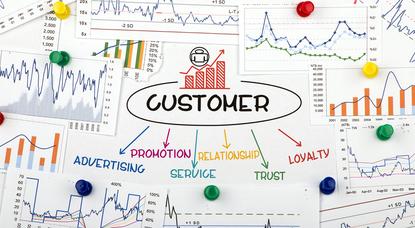Report: Organisational silos and culture inhibiting data-driven marketing
- 30 June, 2016 16:32

Organisational silos and embracing a data-driven culture are hindering marketers from adequately tapping data to improve customer experiences, a new report claims.
According to a new survey of global marketing leaders produced by the CMO Council in partnership with SAP Hybris, entitled Context, Commerce and Customer: Best Practices to Exceed Expectations, 55 per cent of respondents are actively working on systems to extend marketing’s view of the customer to include insights from all impact and interaction points along the customer journey. However, 17 per cent are not convinced a live data ecosystem view via dashboards is possible in their organisation.
The report highlighted data access as a key reason for this issue. One-quarter of respondents claimed only 25-50 per cent of their data is being leveraged in real time for actionable insights. In addition, 21 per cent said organisational silos were inhibiting their ability to harness the right data sets for customer success, while 20 per cent were challenged with getting the rest of the organisation to be data-driven.
One-fifth also claimed there’s too much data to manage effectively, and 12 per cent said data was ‘messy’.
The top sources of data being used by marketers is most commonly marketing and sales intelligence such as contact-level data (81 per cent), campaign data (69 per cent), billing or payments data (50 per cent) and sales data (49 per cent).
Data sources sought after from across the business but least accessed at present include machine learning or predictive analytics (8 per cent), commerce data (11 per cent), psychographic data (12 per cent), HR insights (13 per cent) and predictive, batch-based analytics (16 per cent).
Not surprisingly, only 4 per cent of respondents said they are powering customer interactions in every channel with real-time, personalised experiences, and 23 per cent said they’re a long way from such success. Thirty per cent said a strategy is in place but they’re struggling to align intelligence, content and channels with the customer, and 23 per cent there’s some real-time personalisation going on but only in select digital channels.
The report also looked at technology utilisation and found 39 per cent of marketers believe their investments have met expectations in select areas, such as measurement and customer interaction, but fall short when it comes to connecting content, commerce, conversation and campaigns with back-end operational realities, supply chain logistics and organisational capabilities that impact customer experiences at the front end.
There’s a lot of wait and see going on too, with 29 per cent saying it’s too soon to tell whether their investments into marketing and commerce solutions are going to pay off.
There’s also the ongoing issue of proving marketing’s contribution overall. For instance, only 16 per cent indicated marketing technology’s greatest impact has been driving revenue growth and bottom-line health.
A major challenge is again cross-functional integration. Just 1 per cent of respondents have achieved seamless alignment across all marketing and commerce processes, for example, with the majority (51 per cent) believing they’re working ‘moderately well’. One-quarter admitted to be struggling to connect all of the dots and 3 per cent are completely disconnected.
“With the advancement of marketing technologies and tools in recent years, marketers have benefitted from greater transparency into the measurement of traditional marketing practices. And while this has helped marketers somewhat, it still falls short of providing a holistic, real-time view of the customer and their interactions at every step of the journey,” said CMO Council’s senior vice-president of marketing, Liz Miller.
“The new challenge will be to extend the processes and platforms that power the customer experience beyond the comfortable walls of marketing. This will be the point at which customer experience stops being a marketing campaign and becomes a focus of a business and a true competitive advantage.”
As part of the research, marketers were also asked to outline the top attributes of customer experience. Fast response times to issues, needs or complaints topped the list at 75 per cent, following by consistency of experience across channels (56 per cent), and knowledgeable staff ready to assist whenever and wherever the customer needs (52 per cent).
When asked to identify the single greatest challenge their organisation will have to address in order to optimise customer experiences, 20 per cent said it was keeping up with the expectations and demands of the connected customer, while 17 per cent it’s about managing and fully leveraging the data being collected.
The report was based on a survey of 170 global marketing leaders, including a mix of B2B and B2C and industry type.
More on using data for customer engagement:
- Case Study: How Flight Centre leveraged data to boost customer experience
- How AMEX is using data to build great mobile-led customer experiences
- How Telstra is applying data analytics to customer experience
- How IAG uses first-party data to drive customer engagement
- Optus: Improving product innovation with a data-driven customer view
Follow CMO on Twitter: @CMOAustralia, take part in the CMO conversation on LinkedIn: CMO ANZ, join us on Facebook: https://www.facebook.com/CMOAustralia, or check us out on Google+: google.com/+CmoAu

